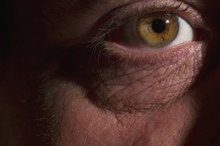Types of Growths on the Eye
Growths on the surface of the eye can be unsightly and frightening. Most growths on the eye, which often occur as people age, pose no threat to health or vision and aren’t cancers. Some growths are cancerous and can metastasize or spread to deeper tissues inside the eye, causing vision problems or requiring surgical removal. Any type of new growth on the eye should be promptly evaluated by an ophthalmologist.
If you are experiencing serious medical symptoms, seek emergency treatment immediately.
Pinguecula
Pinguecula, yellowish growths on the surface of the sclera, the white part of the eye, often occur in people who spent a lot of time in the sun. Although most pinguecula occur in middle aged or older people, children can also develop them, All About Vision states 1. Sun, wind and exposure to dry, dusty condition can irritate a pinguecula, causing redness and a feeling like there’s something in the eye. Artificial tears or steroid drops to reduce inflammation help reduce swelling and discomfort. If a pinguecula interferes with vision, contact lenses or the ability to blink, it may be surgically removed.
- Pinguecula, yellowish growths on the surface of the sclera, the white part of the eye, often occur in people who spent a lot of time in the sun.
- Sun, wind and exposure to dry, dusty condition can irritate a pinguecula, causing redness and a feeling like there’s something in the eye.
Pterygium
Types of Eye Lesions
Learn More
Pterygium, wing- or wedge-shaped growths on the sclera, resemble a film or tissue over the eye and can disturb vision by distorting the shape of the cornea, the covering in front of the eyeball 1. Sun exposure contributes to pterygium development. Mild pterygium require no treatment, but large or irritated pterygium may require surgical removal. Between 3 and 40 percent of pterygium recur after surgery, though, according to All About Vision 1. Grafting of a piece of eye tissue from another area to the damaged part of the eye, called autologous conjunctival grafting, may prevent recurrence.
Conjunctival Tumors
Several cancerous growths affect the conjunctiva, the lining of the eyeball and lower eyelid, Wills Eye Institute’s Ocular Oncology website states. Conjunctival melanoma, the most serious type, looks like a brown or pink nodule on the eye and metastasizes, or spreads to other areas in 20 percent of cases. Invasion into the eye or the orbit, the area surrounding the eye, can require extensive surgery, Wills warns. Conjunctival squamous cell carcinoma, a pink nodule on the eye, can also spread deeper into the eye. Conjunctival primary acquired melanosis looks like a flat brown spot on the surface of the eye and may, in some cases, develop into melanoma. Conjunctival tumors are surgically remove 4d
- Several cancerous growths affect the conjunctiva, the lining of the eyeball and lower eyelid, Wills Eye Institute’s Ocular Oncology website states.
- Conjunctival melanoma, the most serious type, looks like a brown or pink nodule on the eye and metastasizes, or spreads to other areas in 20 percent of cases.
Iris Tumors
What Eye Problems are Typical With Crohn's Disease?
Learn More
Tumors in the iris, the colored part of the eye, usually are benign and don’t grow, but malignant melanomas can also appear in this area, the Bascom Palmer Eye Institute warns 23. A change in a nevus, a pigmented spot on the iris, needs evaluation. Melanoma treatment may consist of surgical removal of the tumor, radiation or enucleation, removal of the eye.
Related Articles
References
Writer Bio
A registered nurse with more than 25 years of experience in oncology, labor/delivery, neonatal intensive care, infertility and ophthalmology, Sharon Perkins has also coauthored and edited numerous health books for the Wiley "Dummies" series. Perkins also has extensive experience working in home health with medically fragile pediatric patients.









